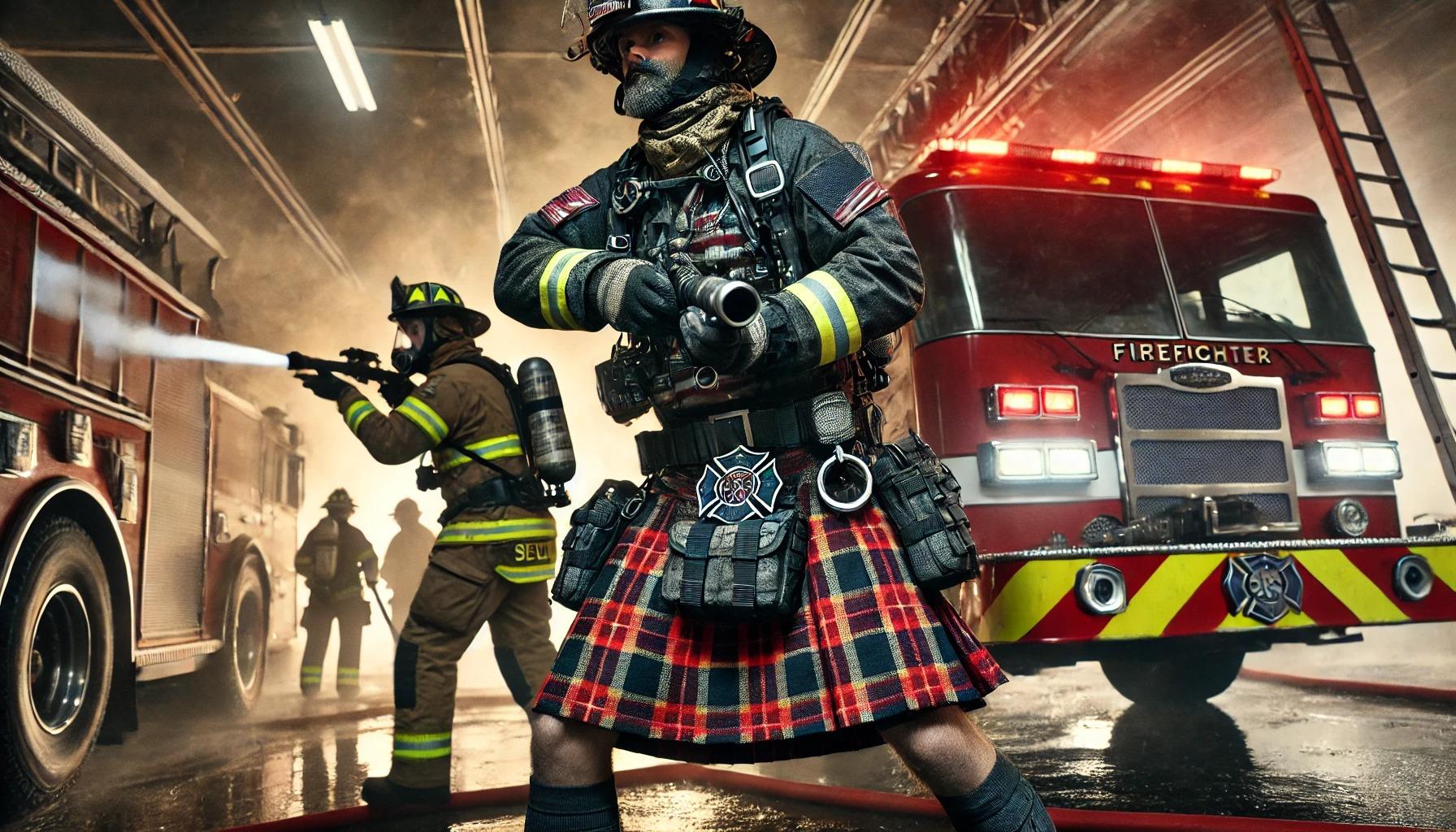Introduction: The Rise of Tactical Kilts in Workwear

Tactical kilts are becoming an unexpected but practical choice for firefighters, utility workers, and tradesmen, offering mobility, durability, and breathability that traditional pants can’t match. Designed with heavy-duty fabrics, reinforced stitching, and multiple pockets, these modern kilts blend heritage with function, making them an ideal choice for demanding physical jobs.
But why are more professionals swapping pants for kilts in high-intensity environments? This guide explores the practical benefits, features, and real-world applications of tactical kilts for firefighters, construction workers, and emergency responders.
1. Why Tactical Kilts Are Gaining Popularity in the Workforce
✔ Enhanced Mobility & Flexibility – Kilts allow for a full range of motion, making them ideal for jobs that require squatting, lifting, and climbing.
✔ Improved Ventilation & Cooling – Unlike pants, kilts allow for better airflow, preventing overheating during hot and physically demanding tasks.
✔ Heavy-Duty Durability – Tactical kilts are made with rugged, reinforced fabrics designed for tough work environments.
✔ Convenient Storage & Utility Pockets – Many kilts come with cargo-style pockets and tool loops, making them highly functional for on-the-job use.
✔ Unique & Comfortable Alternative to Work Pants – Workers who prefer looser, more breathable clothing find kilts to be a comfortable, non-restrictive option.
🚫 Traditional wool kilts aren’t suited for hard labor, but modern tactical kilts solve this issue with performance-driven materials.
✔ Example: Firefighters and paramedics working in hot climates prefer kilts because they stay cooler while still offering protection and durability.
✔ Tip: If you work in outdoor or extreme heat conditions, a tactical kilt can reduce body temperature and increase comfort.
2. Key Features of Tactical Kilts for Utility & Emergency Workers
a) Built for Tough Work Environments
✔ Heavy-Duty Fabrics – Tactical kilts are made from ripstop cotton, canvas, and poly-blend materials that withstand harsh conditions.
✔ Reinforced Stitching & Seams – Designed to prevent tearing or fraying under pressure.
✔ Water-Resistant & Fire-Resistant Options – Some models come with flame-retardant coatings for added protection.
✔ Example: Firefighters in wildland firefighting teams sometimes wear kilts as part of their station attire to stay cool before gearing up.
✔ Tip: If your job involves high temperatures or potential fire hazards, choose a fire-resistant tactical kilt.
b) Practical Utility Features for Worksite Efficiency
✔ Multiple Cargo Pockets & Tool Loops – Keeps tools, gloves, and small equipment easily accessible.
✔ Adjustable Waistbands & Belt Compatibility – Ensures a secure, comfortable fit while on the move.
✔ Built-in D-Rings & Carabiner Hooks – Allows for quick attachment of gear and tools.
✔ Example: A utility worker wearing a tactical kilt with deep cargo pockets can store pliers, flashlights, and utility knives while keeping hands free.
✔ Tip: Look for a kilt with reinforced belt loops that can hold a heavy-duty tool belt.
c) Breathability & Cooling Benefits
✔ Open Design for Maximum Airflow – Prevents overheating in extreme work conditions.
✔ Quick-Dry & Moisture-Wicking Fabrics – Ideal for humid or sweat-inducing jobs.
✔ Layering-Friendly for All Seasons – Can be worn with leggings or work thermals in colder weather.
✔ Example: Utility crews working in desert regions prefer kilts to stay cool while maintaining full mobility.
✔ Tip: If you work in hot, humid climates, choose a kilt with mesh ventilation panels for extra airflow.
3. Why Firefighters Are Embracing Tactical Kilts
Firefighters require clothing that is lightweight, breathable, and easy to move in, making tactical kilts a great alternative to work pants.
✔ Cooling Relief After Heavy Gear Wear – Firefighters often wear kilts between shifts to help their bodies recover from the heat stress of turnout gear.
✔ Pre-Shift & Post-Shift Comfort – Many firehouses allow kilts as part of station wear for relaxation before putting on full protective gear.
✔ Symbol of Brotherhood & Tradition – Some firefighters wear kilts to honor Scottish and Irish fire service heritage.
✔ Example: Many firefighter charity events and memorials feature firefighters wearing kilts to celebrate camaraderie and tradition.
✔ Tip: If you're part of a fire department with Scottish or Irish roots, a tactical kilt can be a meaningful uniform addition.
4. Tactical Kilts for Utility Workers & Construction Crews
Utility workers and construction crews need durability, storage, and comfort, and tactical kilts offer all three.
✔ Perfect for Climbing & Heavy Lifting – Unlike pants, kilts don’t restrict movement, making them great for electricians, cable installers, and linemen.
✔ Reduces Heat Stress on the Job – Workers exposed to hot sun or high temperatures stay cooler in kilts than in thick work pants.
✔ Easy Access to Tools – Tactical kilts feature tool loops, side pockets, and reinforced stitching for worksite efficiency.
✔ Example: A lineman working on electrical poles in the summer can wear a kilt for ventilation while using side pockets for small tools.
✔ Tip: If your job involves lots of movement and tool use, choose a kilt with reinforced pockets and belt loops.
5. Where Tactical Kilts Are Being Used
Tactical kilts are becoming popular across multiple physically demanding professions:
✔ Firefighters & EMTs – Used as station wear and ceremonial dress.
✔ Utility Workers – Worn by electricians, plumbers, and maintenance crews.
✔ Construction & Trade Jobs – Ideal for roofers, carpenters, and builders.
✔ Military & Law Enforcement – Tactical kilts are used for drills and off-duty wear.
✔ Outdoor & Adventure Professions – Perfect for hikers, tour guides, and wilderness survival experts.
✔ Example: Tactical kilts are commonly worn at firefighter charity events and competitions, where they symbolize brotherhood and resilience.
✔ Tip: If your workplace allows alternative uniforms, tactical kilts could be an efficient and practical option.
6. How to Choose the Right Tactical Kilt
When selecting a tactical kilt for work and extreme conditions, consider these factors:
✔ Material: Look for ripstop fabric, cotton-poly blends, or fire-resistant materials.
✔ Pockets & Storage: Choose a design with cargo-style pockets, D-rings, and belt loops.
✔ Fastening System: Opt for Velcro, snap closures, or adjustable waistbands for flexibility.
✔ Reinforced Stitching: Ensures durability in high-stress conditions.
✔ Weather Resistance: Consider waterproof or quick-dry options if working in wet environments.
✔ Example: A heavy-duty canvas tactical kilt with cargo pockets and reinforced stitching is ideal for construction sites and outdoor labor.
✔ Tip: If you need extra protection, consider kilts with fire-resistant coatings or added knee-length coverage.
Final Thoughts: Tactical Kilts as the Future of Workwear
Tactical kilts are proving to be a comfortable, durable, and functional alternative to traditional work pants. With superior airflow, built-in storage, and high-performance materials, they offer a practical and stylish solution for firefighters, utility workers, and tradesmen.
Key Takeaways:
✔ Kilts offer better mobility, breathability, and flexibility than traditional work pants.
✔ Firefighters wear kilts as station wear to cool down between shifts.
✔ Utility workers and construction crews use tactical kilts for comfort and tool storage.
✔ Modern kilts feature cargo pockets, reinforced stitching, and fire-resistant options.
✔ The trend of tactical kilts is growing in demanding professions due to their functionality and durability.
As more industries embrace comfort and practicality, the tactical kilt is proving to be more than just a fashion statement—it’s a workwear revolution!

